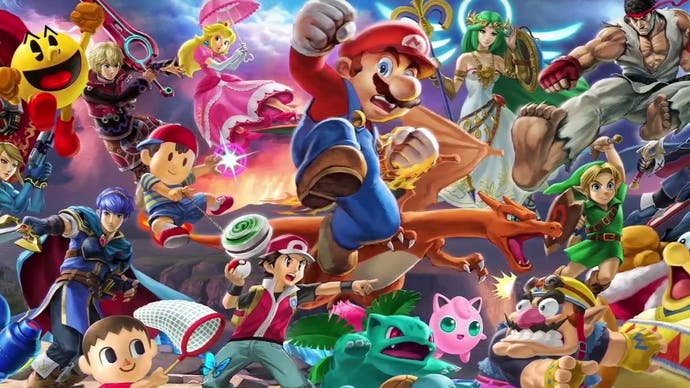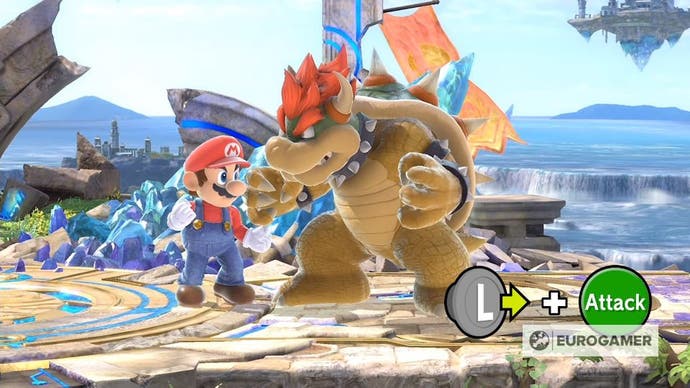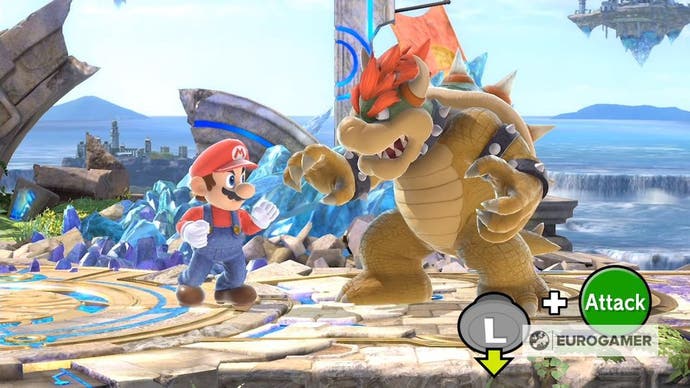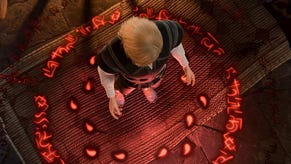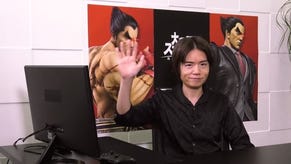Super Smash Bros Ultimate tips, from the basics to more advanced strategies
Beginners and more advanced Super Smash Bros Ultimate tips, as well as some of the best items you can find.
Super Smash Bros Ultimate is here and selling by the bucket load, and so you'll have plenty of competition on your hands.
If you're new to the game, some of the fundamentals of Smash Bros' combat will seem a little counter-intuitive to fans of traditional fighting games - which is where our Super Smash Bros Ultimate tips can help.
A long time player but a little rusty, or simply want to improve? Our advanced Super Smash Bros Ultimate tips can provide some broader strategies to improve your game - especially in multiplayer.
Once you've learned the basics, find out how to unlock characters in Super Smash Bros Ultimate and the best fighters in our Super Smash Bros Ultimate tier list, plus everything we know about Super Smash Bros Ultimate DLC.
Beginners Super Smash Bros Ultimate tips
We've pulled together some of the most common areas of confusion, and provided a quick explanation of each concept so that you can start mastering the finer details of the game nice and quickly.
Achieving KOs
If you look at the bottom of the screen, you'll be able to see a percentage marker for each of the characters in combat. This rating begins at zero when a match begins, and increases as the character in question takes damage. As this number increases, so does the character's "knockback" rating - the distance the fighter travels when thumped.
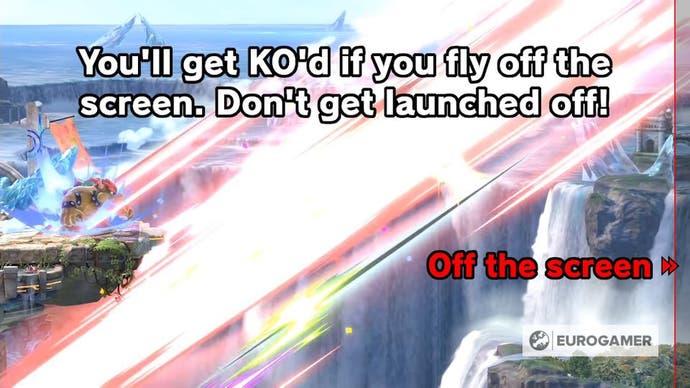
You can think of each stage as representing a large box. When a character moves beyond the boundaries of this area, a KO is called. This resets the loser's damage percentage back down to zero, before the character appears once again from the top of the screen.
Note that to score a KO you have to be the last player to land damage on an opponent before they're knocked out. If the player accidentally damages themselves when falling out of the arena, they still lose a life, but no-one gets credit for the KO.

Movement
Keep in mind that there's a double-jump system at play in Super Smash Bros, and making deft use of this skill is essential if you're to recover from a particularly nasty knockback. Most characters can also make use of a recovery move which propels them up and away from danger.
Try using this skill in combination with the double-jump to boost your chances of survival even further. If you need to drop down a level to get out of harm's way, either hold down or double-tap the directional stick downwards.
Combos
The combo system in Super Smash Bros works a little differently to the kind of systems you'll be used to in other fighting games, thanks largely to the knockback system which can often push your opponent too far away for your follow-up attack to connect.
You also have to consider how the character will likely choose to double-jump away following your initial hit (known in the community as their "tech"). If your opponent shows a tendency to swing to the left after taking a knock, you should be ready to do likewise, so that your follow-up attack has a higher chance of connecting.
While it's true that certain combos can be performed successfully without accounting for this rapid switch in positioning, it's worth gauging your opponent's tendencies over the course of a match to increase your chances of delivering multiple devastating blows.
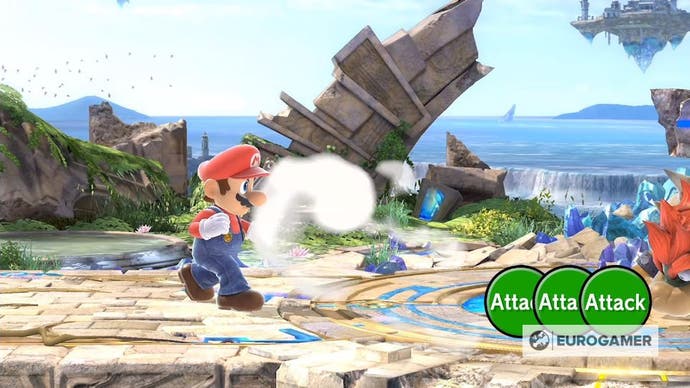
Smash Attacks
Smash Attacks deliver powerful blows which also causing high knockback. They're performed by pressing A while pushing the stick as far as possible in a single direction. Each character typically has four different Smash Attacks, one for the up, left, down and right directions.
These attacks can be particularly useful when you want to finish off a combo in style, or when your opponent's not paying attention. Don't be reckless when using these moves though, as they can be quite easy to dodge, and they leave you somewhat vulnerable to your opponent's counter-attack.

In general, they're best saved for when you can be very confident that the attack will land. As an example, consider a time when your opponent's been knocked off the stage and is trying to get back up. Stand near the edge of the area and wait for your enemy to get close, then whack 'em hard with your Smash Attack. You can also get a cheeky bit of damage in while two different players are fighting each other and are distracted.
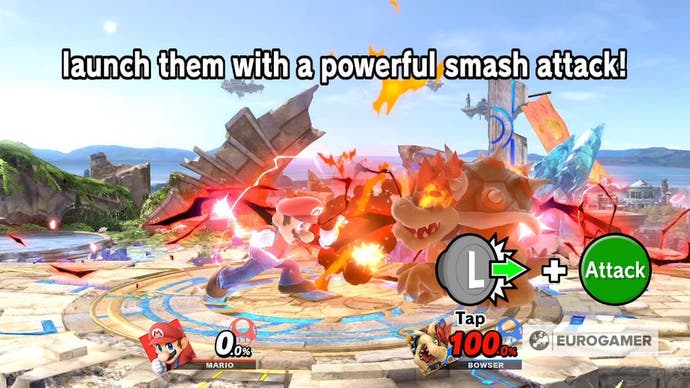
Tilts and Aerial Attacks
While these two manoeuvres aren't generally quite as powerful as a Smash Attack, specific varieties of them are, and these zippy moves are good to work into your combos. Rather than driving the directional stick as far as it can go, you just need to move it a little in the desired direction to get the move underway.
Be mindful of the slight lag in your character actions after pulling off a Tilt or an Aerial Attack. There'll be a limit to how quickly you can follow-up on one of these assaults, so make sure you don't leave yourself in too vulnerable a position afterwards.
Special Moves
The B button is there to help you pull off your so-called Special Moves. Mario, for example, has a fireball that he can fling around. Some characters have special moves best suited for close-quarters combat, while others will find their unique skills to be much more useful when delivered at range. Really, it's a case of experimenting with the entire roster, and finding the character that works best for you.
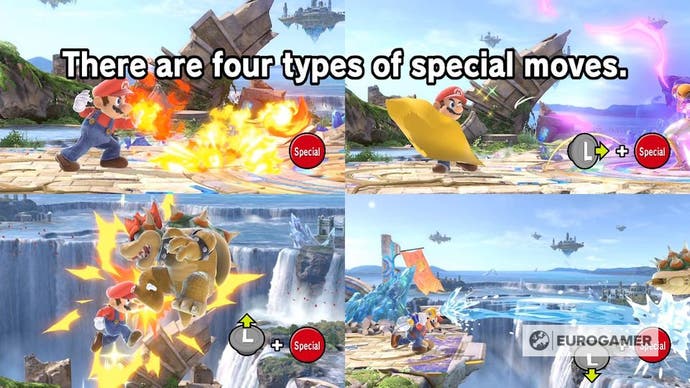
Shielding
The core defence mechanic in Super Smash Bros is known as Shielding. By holding down your Shield or Block button you create a bubble around your warrior. Keeping that button held down causes the bubble to get smaller, and if it gets too small it'll break, leaving your character defenceless and temporarily stunned. Release the button, however, and it eventually recharges.
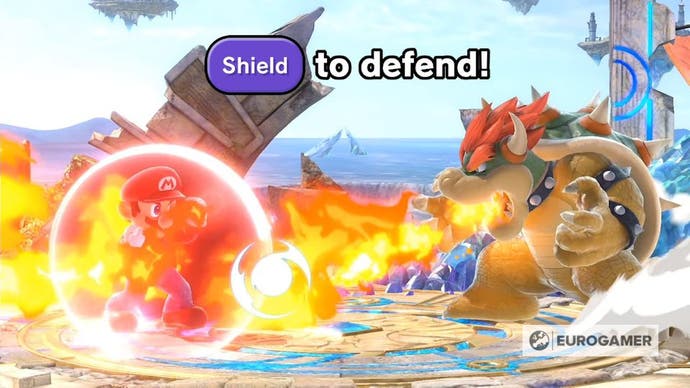
Note that any part of your character left outside of the shield can be hit by your opponent. A mark of skilled play in the game is to be able to dish out a little damage while the enemy thinks they are well protected. Moving left or right while shielding also allows you to roll away from danger, although keep in mind that you're vulnerable for a brief period of time while on the move.
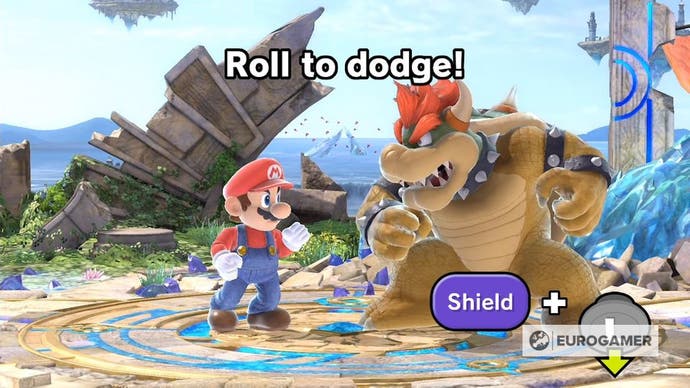
Grabs
Grabs - throws if you like - is one of the methods you have for bypassing an opponent's defences entirely, and even shielded characters won't be able to escape your clutches. The majority of characters in the game have a variety of grabs which are again separated by the directional controls. Note that certain characters like Samus or Link have tether grabs that can be used to latch onto the scenery itself, and can avoid tumbling off the stage altogether.

Recovering
A couple of things can happen when your fighter has been knocked off the stage. Either you're knocked so far out of bounds that a KO is triggered, or you're moved well away from the middle of the stage and find yourself needing to get back to the centre. This is commonly known as recovering in Smash Bros.
Each one of the fighters in the game has a special recovery move (typically put into play by pressing B and up at the same time), that fires them into the sky. Often your best route to getting back into action is to get as close to the stage as you can, double-jump, then use your recovery move.
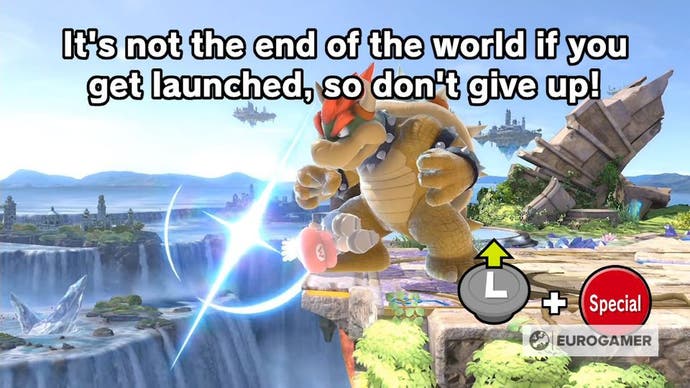
Advanced Super Smash Bros Ultimate tips: How to get better at Smash
Reading your opponent
The ability to read your opponent is an essential skill in any fighting game, but it's far more important to hone your instincts in Super Smash Bros. It's relatively easy to read a combo chain in other games, and what exactly each character has to do to arrive at its most powerful attacks. In this game, there are many more ways to begin each offensive manoeuvre, making it tougher to read an opponent.
You also have to plan for your opponent's reaction once you've landed your first blow, and how they might choose to evade any follow-ups. Get this wrong and your combo will likely collapse. Then there's recovering, and being prepared to counter your enemy's own comebacks.
As a result, it's almost more important to understand your opponent's typical reactions, rather than concentrating on your own performance. Once you've mastered your character's combat style, let your muscle memory do the thinking, and try to familiarise yourself with how your enemy reacts to danger and sets up offensive chains. Do they shield when you get near? Do they roll away from danger or try to grab you? This is the kind of intel that will win you matches.
Using items
Don't get too hung up on favouring specific items. All of them are useful in some capacity (even if some are more useful than others!), and so all of them can show up in a random multiplayer match. There's no point avoiding mastery of a particular item because it doesn't suit your playstyle - sometimes it'll be all you've got. If nothing else, you can always fling the majority of items at enemies to stop them recovering.
The best offence...
New players have a tendency to play extremely aggressively in Super Smash Bros, getting up-close at all costs and pummelling as much damage into their opponent as they can, as quickly as possible. Even those who prefer to fire projectiles from range seem to have an aversion to shielding up.
You must get used to defending yourself appropriately, and leaping and dodging away from danger when necessary. If your opponent can't hit you, they can't score a KO, and the longer you frustrate an opponent, the greater the psychological edge you'll have over them. Wait for them to make a mistake out of frustration, and then punish them for it.
What is Edge guarding in Super Smash Bros Ultimate?
Edge guarding is the process whereby you attempt to prevent your recovering opponent from making it back onto the stage. The exact method involved varies depending on the character you're playing, as the best way of pulling this off is to make use of your special moves. With practise, you can pre-empt your opponent's recovery with some mid-air shenanigans, score your KO, then get safely back onto the main platform with a snazzy bit of double-jumping.
Practice makes perfect
Spend as much time as you can honing your skills and practising with the entire roster of characters in both World of Light and Classic mode. You may have a favourite character on paper, but your actual skill with each fighter may vary wildly from your expectations.
Though the Super Smash Bros Ultimate character unlock scheme might be a grind, it actually forces you to use players you might not be familiar with - and that's a good thing.
Once you've determined your playstyle, focus on those characters that compliment that approach to combat until you've found one you can master for competitive play. Do you like to constantly be on the move? Consider Fox or Falco. Those who prefer to stand back and fling damage around should look into characters like Villager, Link or Toon Link.
Some of the best Super Smash Bros Ultimate items to look out for
Some of the most powerful items in Smash Bros are typically switched off for big tournaments, but if you just want to muck around in a local party session we recommend leaving them on. There are a fair few to choose from, so we've put together a quick guide to how they work, and which ones you should prioritise taking when they show up.
Freezie
Freezie was one of the best items you could use in the Melee edition of Super Smash Bros, but it was so powerful that it was downgraded quite a bit for Brawl. But, it's still effective at pinning enemies in place for a short amount of time.
Anyone hit with this item will be stuck in place, allowing you to throw out whatever damage you can muster at the time. You can expect your opponent to either shield up or roll out of the way when the effect finishes, so be ready to react to keep the damage flowing.
Home-Run Bat
Take a Home-Run Bat to the face in Super Smash Bros and you're almost guaranteed to be KO'd. Not only that, anyone standing near to you and caught up in its area-of-effect will likewise be clobbered. Grab this item the moment you see it appear on the battlefield, and be sure to make your golden opportunity count.
Master Ball
The Pokéball was always a solidly dependable item in earlier Smash Bros games, and while the exact effect was random, you could be pretty confident of pulling at least a fairly useful Pokémon from it. The Master Ball variant was a new addition to Smash Bros for Wii U and 3DS, and the main difference is that it always creates a legendary Pokémon.
Not every creature packs a particularly mighty punch, or helps you deliver a solid KO, but there are enough truly terrifying Pokémon to make this power-up an absolute must. Even if you get a relatively rubbish buddy, your opponent still has to initially react as though you're about to pull out an amazing one. Make sure you capitalise on this fear!
Ore Club
Introduced in the Wii U and 3DS editions of the game, the Ore Club has a few different uses. As a primitive weapon, it packs a decent amount of damage. Use it as a Smash Attack, however, and you'll whip out a powerful tornado that spreads out over a large section of the screen, knocking back any opponents it touches. Even better, the tornado moves slowly enough that you can use it to chain combos together.
The Ore Club also grants armour to the wielder when it's used as a Smash Attack. If you take damage while doling out some of your own, you'll stick to the spot and carry on dishing out the pain. You can also throw the club at an enemy to help push them closer towards a KO.
It's handy for edge-guarding too, thanks to its bouncing property. Try to push an enemy off the stage, then throw the Ore Club when they get near to you again. Whack 'em, and there's a good chance the club will come back to you, allowing you to grab it and then throw it again straight away. Get your timing and positioning right here and your opponent won't stand a chance.
X Bomb
The X Bomb is another item introduced in Super Smash Bros for Wii U and 3DS. Throw this bomb into the air and it'll spin around and spit out four continuous laser beams, and it's very hard to dodge the damage. Drop everything to pick this item up, and send your opponents on a merry dance away from its devastating effects.
